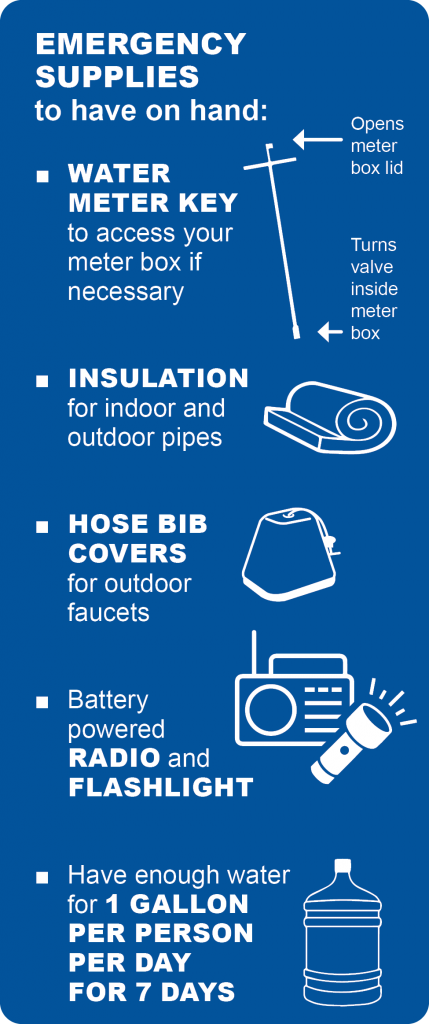Winter Weather PREPAREDNESS TIPS
Busque a continuación una versión en español de información sobre preparación para el clima invernal
Prepare for Freezing Weather
- LOCATE YOUR WATER SHUTOFF
Make sure everyone in your residence knows where the water main shutoff valve is located and keep it clear of debris and obstacles at all times. Some homes have shutoff valves on their side of the meter, if you do not know if you have one, check the inspection report from when you bought the house. For renters, please consult with your property manager. If you cannot find your shutoff valve or if it is damaged, then you should be prepared to access the shutoff valve in the meter box. Make sure your meter box is cleaned out and you can access the shutoff. You may need a water meter key that can be used to open the box and turn the shut off valve, these can be purchased at most hardware stores. - KEEP OUT COLD AIR
Tightly close doors and windows to the outside. Make repairs to broken or drafty windows, doors, and walls. Seal all leaks in crawl spaces. Winterize unheated spaces and close garage doors for the duration of the freeze. - EXPOSED PIPES AND WATER HEATERS
Insulate pipes in unheated and drafty areas, such as an attic or garage. Also check manufacturer recommendations for your tanked and tankless water heaters. Hardware and plumbing supply stores carry insulation to help keep pipes from freezing. - OUTSIDE FAUCETS
Turn off outside faucets. Remove all connected hoses and wrap faucets with towels or a Styrofoam insulator. Turn off and drain automatic sprinkler systems. If you have an RPZ on your sprinkler system, to prevent it from freezing, make sure it is insulated properly. The best way to prevent it from freezing and causing a water leak is to cut it off and drain it. - PREPARE BEFORE LEAVING TOWN
If you plan to be away during a time when freezing temperatures are possible, turn off your water at the meter and set your thermostat to 65 degrees or higher.
During Freezing Weather (1-2 days)
- PROTECT INDOOR FAUCETS
Open cabinets beneath kitchen and bathroom sinks to allow warmer air to circulate around pipes. Be sure to remove any toxic substances located in these cabinets if there are children or pets living in the residence. - DRIP (stream) YOUR FAUCETS
You should drip your faucets slowly if the tempatures get below freezing. If the temparture gets significantly lower then freezing, it is recommended you lightly stream your faucets especially if the pipes in your house are prone to freezing.
Thawing Pipes After a Freeze
After a period of freezing weather, if you turn on a faucet and discover only a trickle of water coming out, or no water at all, it is possible you have a frozen pipe or water meter. Take the following steps:
- TEST ALL FAUCETS TO SEE WHICH ARE FROZEN
If you find that none of your faucets are working, then the frozen pipe
is located near the main water pipe entering the residence. If none
of the faucets on the same floor are working, then the frozen pipe is
located between the different floors. If none of the faucets in the same
room are working, then the frozen pipe is located between the main
water pipe and where the water enters the room. - FIND THE FROZEN PART OF THE PIPE
After you figure out which pipe is frozen, trace along the affected pipe
to look for signs of freezing like bulges, frost, or ice. If there are no
visible signs, pay attention to the pipe’s temperature and find where
the pipe feels the coldest. - THAW THE PIPE SLOWLY
Even the faintest trickle of water will help thaw a frozen pipe. If any of
your faucets can run any water at all, turn them on. Completely open
the cold-water faucet closest to the frozen pipe to relieve pressure
and reduce the chance of breakage. If the frozen pipe is only in one
area, you may be able to thaw the pipe by opening cabinets and
allowing warmer air to circulate around the pipes. Use warm water to
soak towels, then wrap the towels around the frozen pipes. You can
use a hair dryer or a portable heater to thaw a pipe, but DO NOT use
electrical appliances if there is standing water. - NEVER thaw a pipe using an open flame.
Checking your House for Water Leaks
After the weather has warmed up, Here are some ways you can check for water leaks:
- Make sure no water is running in your house. This means no dripping of faucets, washing machine, or toilets running.
- Find your water meter. If the dial on your meter is turning, then you probably have water leaking somewhere.
If these steps do not work, contact a licensed plumber.
Here are some other websites with information on freezing weather.
Red Cross
National Weather Service

 Winter weather
Winter weather